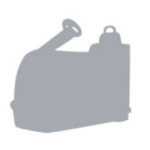LEAN MANUFACTURING
Looking for cost cut and optimisation production facilities can not afford to ignore the relevance of processes related to internal logistics. Even the best organized manufacturing process will not be complete and trully efficient without proper material handling. The idea of our products is to optimise the transport of materials in factories so that transportation does not only take place on time but also it is adapted to the specifics of the certain production. Using a forklifts is essential for warehouses, where the transport of materials is carried out both horizontally and vertically, but on the production’s side it might be inefficient ( low yield ) and also pose a danger for production’s employees.
The following comparison is an example of the differences between transport using a standard fork-lift truck and a lean manufacturing logistic train used in internal logistics.
STANDARD FORK LIFT

E-LINER LOGISTIC TRAIN

CAPACITY TEST - MAXIMAL WEIGHT OF TRANSPORTED GOODS
2000 kg
5000 kg
VOLUME TEST - QUANTITY OF 1200 X 1000 PALLETS WHICH CAN BE TRANSPORTED DURING ONE TRIP
1 pallet
5 pallets

ROUTE TEST - TRANSPORT OF GOODS OF 5000KG WEIGHT (5 PALLETS OF 1000KG EACH) BETWEEN TWO POINTS AWAY FROM EACH OTHER 1KM
10km's route
5km's of dry run
2km's route
1km's of dry run
TIME TEST - TRANSPORT OF GOODS OF 5000KG WEIGHT (5 PALLETS OF 1000KG EACH) BETWEEN TWO POINTS AWAY FROM EACH OTHER 1KM
40 minutes - with forklift's speed 15km/h

12 minutes - with tugger train's speed of 10km/h
SUMMARY
In case of high material rotation frequency and highly developed production line transport with use of forklift is roughly 2,5-5 times less effective not taking into account the safety and need to wider routes to maneuver.
The above examples clearly demonstrate that the milkrun tugger logistic train lean manufacturing transport system is much more efficient than forklift intralogistics.
